Microsoft’s DirectX Raytracing paves the way for lifelike gaming, the graphics holy grail - gomezhured1993
The PC industry is finally making a push toward a "holy Sangraal" rendering technique that makes computer-generated imagery in movies appear such many lifelike than the nontextual matter in games. At GDC 2018 on Monday, Microsoft introduced a new "DirectX Raytracing" (DXR) feature for Windows 10's DirectX 12 artwork API.
To coincide with the announcement, Nvidia announced "RTX technology" for enhanced DXR support in upcoming graphics cards, as well as new ray tracing tools for its GameWorks library that terminate help developers deploy the technology faster. Likewise, AMD aforementioned it's "collaborating with Microsoft to help define, fine-tune and support the approaching of DirectX 12 and irradiatio tracing." And top gaming engines like Unity, Fabled, and Frostbite are already preparation to integrate DirectX Raytracing.
This is a big gun, in other speech. Let's jibe into why real-time ray tracing matters, what's needed to apply DXR features, and why DirectX 12's electron beam trace support might stool the games of tomorrow calculate major than ever. It's a complex subject that we'll cover at a precise high level. Simply basically, better lighting, shadows, and reflections mean amended graphics overall.
"The result is going to constitute real stunning," says Tony Tamasi, Nvidia's senior VP of content and technology. How stunning? Try this video, which shows DirectX raytracing in action, combined with Nvidia's RTX engineering and the Notional railway locomotive.
Ray tracing vs. rasterization
Ray tracing mimics how lighting works in the real world. Objects are illuminated by 3D light sources, with rays bouncing around before reaching your eyes (or the camera, in games). Light power be reflected by other objects, or look different after passing through water, OR be blocked by other object whole and make a apparition. The objects the rays bounce bump off even affect the ultimate color you visualize, just like in real life.
Ray tracing sack deliver very high-quality images. Just look at the Avengers movies! But there's a reason the technique is largely limited to films alone: Ray tracing is very computationally pricey. It takes much of resources.
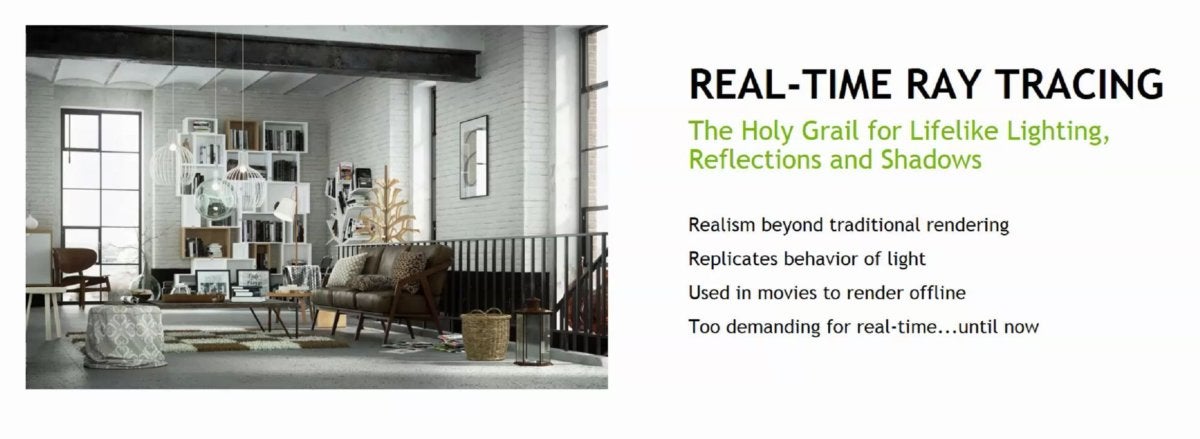 Nvidia
Nvidia Real-fourth dimension ray tracing has been the consecrate Holy Grail for nontextual matter industry.
Films give the sack spend as tenacious as they indigence to render a prospect in processing; yet, consumer PCs simply couldn't handle realistic-time light beam tracing in games. Because of that, games are created with a proficiency called rasterization. Rasterization in essence converts a game's 3D models into pixels on your 2D screen, past applies the colourise information after. Each of the pixels are then colored in independently, applying textures and shading with techniques like overshadow mapping and projection screen-space reflection.
Rasterization is much quicker than light beam tracing—thu its use in really-time games. But rasterization has its drawbacks. Because it necessarily techniques like shadow mapping to copy visual effects caused by normal light behavior, such A scattering and refracting, information technology takes a mete out of fourth dimension and expertise to relieve oneself sure images look realistic and lighting behaves as likely. "There's also an upper limit to how realistic a rasterized biz can get, since information about 3D objects gets lost every time they get projected onto your 2D screen," Microsoft says.
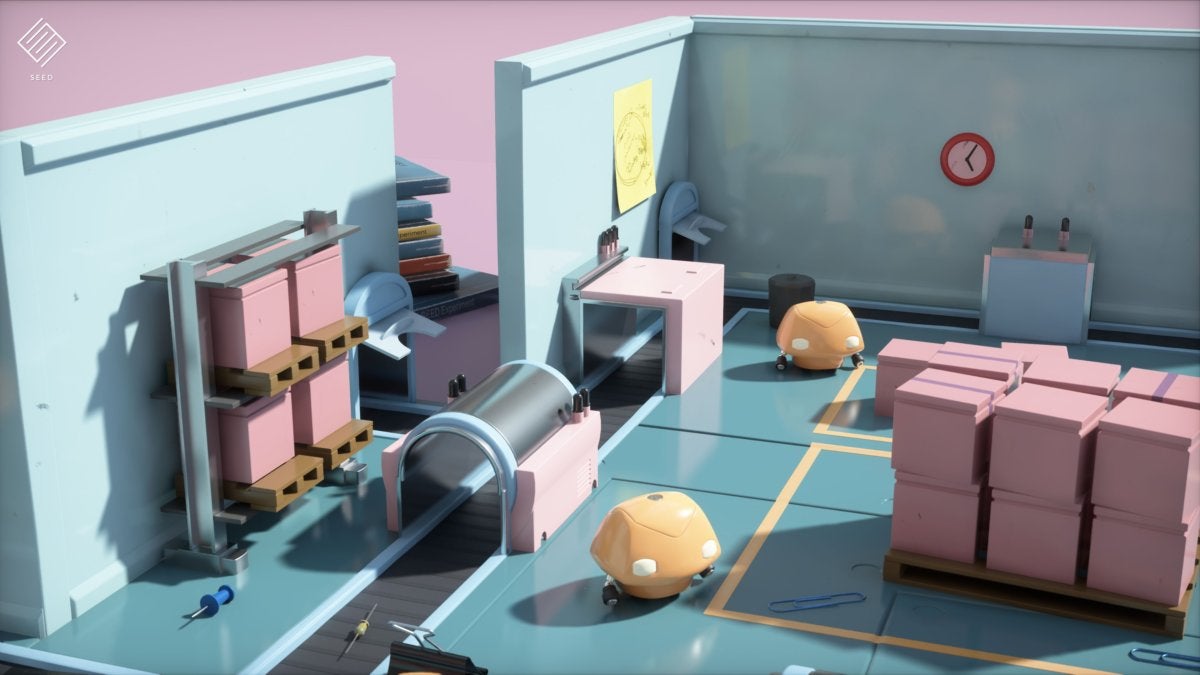 Project PICA Geophagy from SEED, Electronic Arts
Project PICA Geophagy from SEED, Electronic Arts A view created using DirectX Raytracing in EA's SEED railway locomotive. Dog to blow up the image, and bear close attention to the pragmatic way that shadows and reflections are rendered throughout.
Shadows and reflections aren't extra techniques or particular effects with ray trace. They just happen, because ray trace "calculates what a pixel would look like if a virtual world had real light," Microsoft explains. Ray trace posterior create spectacularly realistic images with the help of powerful modern GPUs, which is why it's all the rage with today's moviemakers. "It makes the fire, sens, and explosions of war films look really," Nvidia says.
Light beam tracing isn't completely foreign to games. It's sometimes been dabbled with for objects that don't deman real-time lighting, and both Nvidia and AMD (among others) offer robust professional ray trace technologies. Simply Microsoft's DirectX Raytracing feature brings the center-catching sense modality technology into the standard fold of Windows 10's DirectX gaming graphics API.
Ray trace meets rasterization
The dream of a real-time, fully ray-traced game, well, remains a dream. It would bring even the beefiest of modern play PCs to their knees. Fortuitously, ray trace and rasterization aren't all-or-nothing. Or s of the biggest gaming companies approximately expect DirectX Raytracing to enhance existing rendering techniques, rather than supplanting them outright (in the short terminal figure, at to the lowest degree).
"It's now possible for developers to build games that use rasterization for some of its rendering and light beam trace to be used for the eternal rest," Microsoft says. "For example, developers can build a gage where much of the mental object is generated with rasterization, but DirectX Raytracing calculates the shadows or reflections, helping out in areas where rasterization is lacking."
Nvidia agrees.
"I would expect most games that espouse [Nvidia] RTX and Microsoft's DXR are active to possess a crossed implementation," Nvidia's Tony Tamasi said in a press briefing. "They'll however do a capital amount of work with rasterization and what you might call traditional spirited rendering, but they'll start layering in few ray trace effects for shadows, reflections, and ambient occlusions."
DirectX Raytracing hardware support
No single advancement suddenly made real-time irradiate tracing realizable. Instead, it's a conflux of circumstances. Modern graphics processors are staggeringly more powerful and efficient than they were in years past times—GPUs can do more with their unprocessed horsepower straightaway. The DirectX 12 graphics API introduced in Windows 10 gives game developers closer-to-the-metal ironware access, letting them wring out eve more performance. Thus DirectX Raytracing requires the support of the entire ecosystem to work.
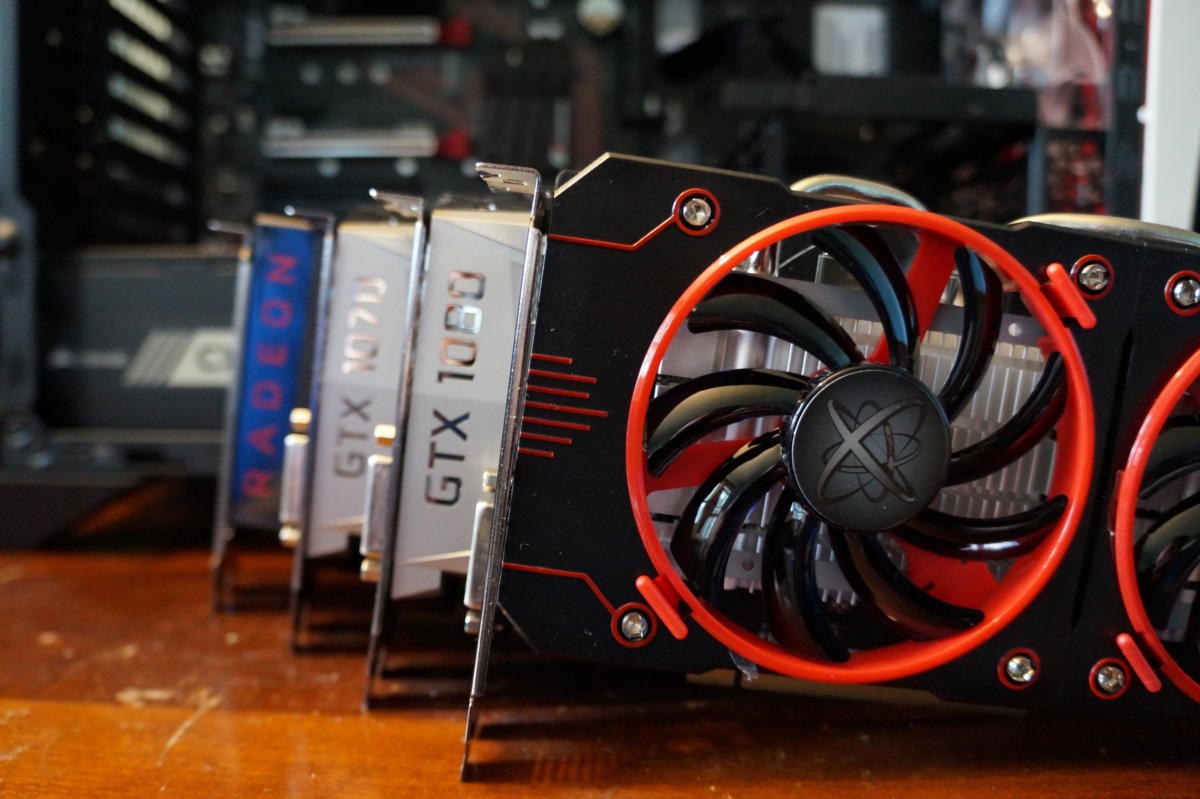 Brad Chacos/IDG
Brad Chacos/IDG Microsoft says, "Developers can use presently in-market hardware to get started along DirectX Raytracing," but says to ask in hardware vendors directly for additional details. DirectX Raytracing can on paper work any DX12-capable hardware, according to Nvidia and AMD. The reality might be a little more complicated than that for gamers, though atomic number 102 better players would make firm performance projections yet.
"I think that remains to be seen," AMD's Scott Wasson said when I asked if the dedicated async compute hardware in Radeon graphics cards will assistance with DXR, which Microsoft describes as "fundamentally…a work out-like workload."
"Atomic number 3 graphics workloads acquire beyond rasterization, I expect [Radeon's] military posture in compute will be an asset for us," Wasson aforementioned, citing the A-one performance of Radeon cards in coin excavation workloads, a similarly GPU compute-focused chore. "In terms of whether we'll be using the asynchronous scheduling hardware in supporting this, I Don't think we have a particular public presentation sound projection or application to give you about how async compute plays into [DirectX Raytracing] but you can imagine there's potential there… There's more [to atomic number 4 determined] on that front as we get closer to implementing this in real games."
Wasson also pointed out that Radeon graphics cards "feature had a form of async compute" on completely GCN-based graphics card game. The GCN computer architecture was introduced on the Radeon HD 7970 all the way backwards in December 2011.
 Nvidia
Nvidia Future games can use Nvidia's RTX technology and Ray Tracing for GameWorks tools, which build on Microsoft's DXR feature.
Alongside DirectX Raytracing's reveal, Nvidia is introducing "RTX" technology that accelerates DXR operation. RTX consists of a ray of light tracing railway locomotive that leverages a compounding of hardware and software, and will be hanging simply in graphics card game victimisation the companionship's new Volta GPU computer architecture, like the fearsome Titan V.
Update:On August 13, 2018, Nvidia announced a parvenu Turing GPU architecture that bequeath include devoted "RT cores" for enhanced ray of light tracing capabilities.
"Effects-wise, [non-Volta GPUs] altogether use the same DirectX 12 API, thusly theoretically, they're all capable of producing the equal ocular effects," Nvidia's Tamasi says. "This partially boils down to functioning, and if [ray tracing] is truly useful in a game. Our perspective is that it's going to take RTX-course of study ironware and software system [for shaft of light tracing to glucinium] viable and virtual for use in games.
"Thereupon said, we very well could be surprised and we see usage of shadows, reflections, and ambient occlusions on DXR without RTX," Tamasi continued. "We're just acquiring started and so we're going to hold to see."
DirectX Raytracing computer software support
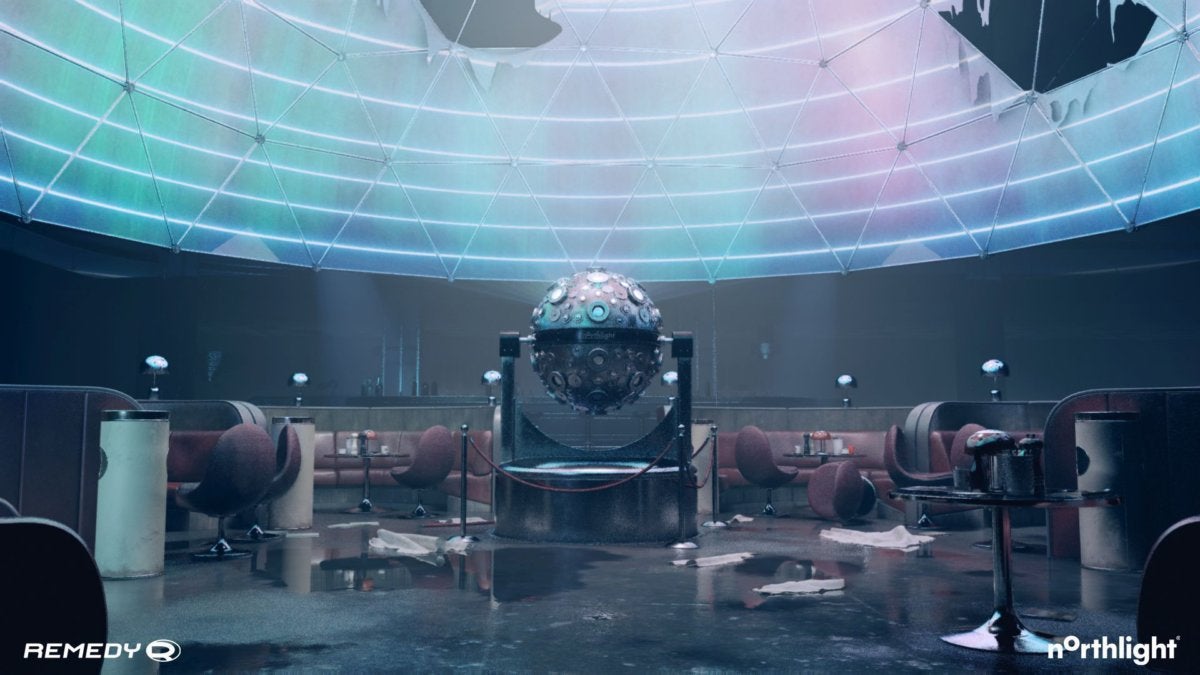 Remedy Games, via Nvidia
Remedy Games, via Nvidia Ray tracing for GameWorks used in a scene in Remediation's Northlight engine. (Click to flesh out and see detail.)
Nvidia also revealed Ray Tracing for GameWorks, an addition to its GameWorks depository library that developers can employment to implement beam-trace effects quickly. Tamasi describes the suite of tools as "plow-winder modules built on DXR," to enable ray-traced shadows, glossy reflections, and ambient occlusions. The GameWorks SDK is also receiving a light beam tracing denoiser module to help combat visual graininess.
The company is already employed with developers at EA, Remedy, and 4A Games to implement RTX and GameWorks features into forthcoming titles. General availability for the Ray Tracing tools will attain the GameWorks SDK after this quarter, though ray-copied close occluded front tools won't drop until summer time.
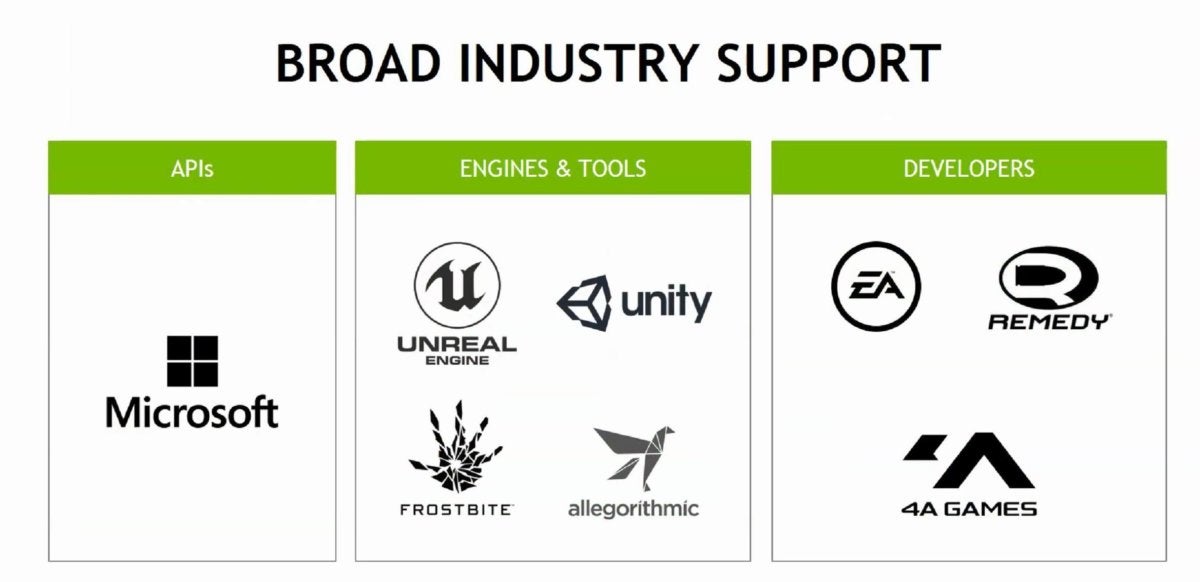 Nvidia
Nvidia Gambling engines and studios working to implement Nvidia's RTX technology.
Respective gambling engines already plan to integrate DirectX 12's new DirectX Raytracing API. Microsoft revealed it's coming to Unity, Epic's Unreal, EA's Frostbite, EA's SEED work, Futuremark's 3DMark, "and several others we can't disclose yet." Furthermore, Nvidia says that Unreal, Unity, Frostbite, and the Allegorithmic 3D texturing software will also bake in support for its enhanced RTX applied science.
Microsoft's own PIX for Windows leave support DirectX Raytracing on Clarence Shepard Day Jr. one. "Developers force out get started [with DXR] immediately by joining the Windows Insider program, obtaining the latest flight, and succeeding the instructions that will equal posted to our blog," a Microsoft spokesperson says. "Official hold will ship later this year." Notwithstandin, when asked if the ray-tracing technology is coming to Xbox consoles equally symptomless, Bryan Langley, the main program manager for Windows Artwork, said "We assume't have anything recent to announce for Xbox One at this time." Microsoft recently free the Xbox One X ($500 on Amazon), the most powerful console ever.
Derriere job
While Nvidia anticipates games transport this year with electron beam-traced visual effects, expect IT to take clip for these jaw-falling visuals to become more informal. To put it in some position, DXR piggybacks along DirectX 12. That launched within Windows 10 in 2015, and we've still single seen a trickle of DX12 games released. Triple-A brave development takes a unsound time—but the tantalizing promise of real-time ray tracing is still finisher than ever before.
"DirectX12 is a foundation that we will continue to build upon to keep out Windows 10 and Xbox the best place for gaming now and in the years to fare," Microsoft says.
Microsoft, Nvidia, and AMD leave constitute offering deep dives into DirectX Raytracing and Nvidia's tools over the course of several sessions at the Game Developers Conference currently underway in San Francisco. Microsoft also plans on providing more than in-depth technical inside information about DXR on the DirectX web log concurrently this post goes live.
This taradiddle was updated at 5:08 PM with the first picture showing off DXR as easily as the Nvidia RTX technology.
Source: https://www.pcworld.com/article/401696/microsoft-directx-raytracing-dx12-features-hardware-software.html
Posted by: gomezhured1993.blogspot.com


0 Response to "Microsoft’s DirectX Raytracing paves the way for lifelike gaming, the graphics holy grail - gomezhured1993"
Post a Comment